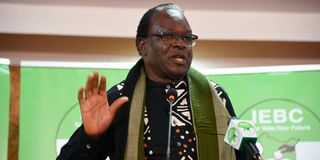IEBC assures Kenyans on security of election technology

IEBC Commissioner Justus Nyang’aya who explained that the Kiems kits will ensure that only voters whose biometric and alphanumeric details have been captured in the voter register are allowed to vote.
The electoral commission has said it has put in place systems to guard against manipulation of election technology kits as well as arrest multiple voting and impersonation on August 9.
The Independent Electoral and Boundaries Commission (IEBC) assured the country that its results transmission system (RTS) will work at an optimal level on polling day despite challenges faced during simulation.
Speaking Thursday, Commissioner Justus Nyang’aya explained that the Kenya Integrated Elections Management System (Kiems) kits will ensure that only voters whose biometric and alphanumeric details have been captured in the voter register are allowed to vote.
This is through the use of electronic voter identification (EVI) and electronic voter verification (EVV) systems that allow only voters registered in a particular polling station to vote.
He said the voter will first be identified biometrically and in the event that fails because of missing fingers or the biometrics were not properly captured during registration, the presiding officer will authorise use of a complementary mechanism that requires an alphanumeric search.
It is after the retrieval of the voter’s details from the Kiems kits, said the commissioner, that one will be allowed to vote.
“The systems ensure that a voter is allowed to vote only once on the polling day, as well as curbing against impersonation, ensuring that only those who registered to vote at a particular polling station are allowed to vote,” said Mr Nyang’aya.
Unique password
Every Kiems kit shall be assigned to a unique polling station, with every presiding officer assigned a unique password to operate the kit, he said.
Should the kits malfunction during identification or results transmission, the presiding officers are required to notify the returning officers of the incident and request a replacement kit that will be documented in the polling station diary as a quality control measure.
“It is only in the event of total failure of technology that the commission as guided by law will be required to suspend or terminate the use of technology and notify the public and stakeholders of the suspension and of the measures put in place,” he said.
Results transmission
Regarding results transmission, he pointed out that each Kiems tablet will be assigned to a unique polling station and every presiding officer given a unique password to open the RTS system.
The system, he said, will only allow the presiding officer to open the RTS application after the close of voter identification.
Consequently, the system will display a checklist for the presiding officer to confirm that the results form (34A series) has been duly filled, has an official stamp, signed by the PO, the deputy PO as well as the agents before the officer is able to transmit Form 34A to the returning officer.
In case a form cannot be transmitted due to network connectivity challenge, the status on the Kiems kits shall appear as ‘pending’.
“When the device manages to re-establish connectivity, the presiding officer shall click on ‘Transmit All’ button and all the forms will be transmitted. No Form can be manipulated once it has been captured by Kiems kit,” he said.
Forms 34A
On the other hand, the returning officer will also have the duty to confirm that all Forms 34A for respective constituencies have been received and verified, per each elective position, so as to preview and generate form 34B that will then be signed and uploaded to the public portal.
“Form 34A for the presidential elections cannot be amended once the form image has been captured by the Kiems kit,” said Mr Nyang’aya.
He said that Election Results Management Framework (ERMF) provides workflow of results from the polling station to the constituency and national tallying centre.





